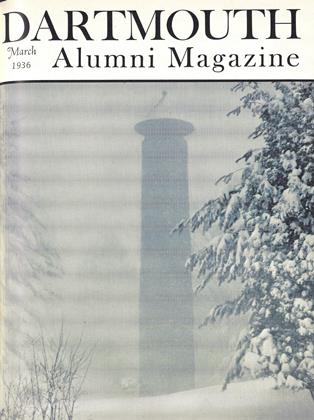By Hugh Morrison '26. The Museum of Modern Art and W. W. Norton & Company, Inc., New York, 1935.
Louis. Sullivan once expressed his architectural credo in the following terms: "Architecture is not merely an art, more or less well or more or less badly done, it is a social manifestation." Architecture was for him the study and expression of the social forces of a particular time and place, and the function of the architect was to produce buildings that would correspond to the most vital cultural needs of a people. The success with which Sullivan realized this high social purpose is pointed out by Lewis Mumford: "Sullivan was the first American architect to think consciously of his relations with civilization .... he knew what he was about, and what is more important, he knew what he ought to be about."
Professor Morrison's excellent study of the life and works of Louis Sullivan is thus in a very real sense a study of a movement, social as well as architectural in its broadest implications, in addition to being a study of a prophet and practitioner of this movement. Sullivan is best known to Chicagoans for his work on the great Auditorium unit, the scene of so many operatic triumphs before the brave days of Samuel Insull and his new opera house; for the magnificent Transportation Building at the World's Fair of 1893; and for his numerous creations in the otherwise prosaic field of commerce, such as the Marshall Field Wholesale Building and the Carson Pirie Scott store building, both of which are still sturdily fulfilling the function for which they were designed for over thirty years ago.
These buildings and the rest of the 134 structures of various types and functions with which Sullivan was closely identified either before or after the dissolution of the famous firm of Adler & Sullivan, are all strikingly illustrative of his fundamental belief in functionalism. Briefly stated, this architectural thesis is that "form follows function," that the architectural form should clearly express the utilitarian purpose of the building, the use to which it is to be put. Thus a railroad station should look like a railroad station and not' like a Roman bath, a library should look like a place to keep and read books and not like a Gothic cathedral, the facade of a bank building should not look like a Greek temple, and if the structure of an office building demands a blank wall, it should be left blank and not interspersed with a number of false windows for the sake of a specious symmetry.
The life of Louis Sullivan is thus the biography of an idea. Professor Morrison is to be congratulated for the painstaking care with which he has traced the evolution of this idea in the life and works of the master, and for his lucid interpretation of its theoretical foundations. The ultimate validity of this idea is apparent from even a casual glance at the work of the great contemporary European architects, whose efforts have the clean-cut, angular simplicity of line, the intimate fusion of form and function that Sullivan so consistently and so ably presaged. And finally, one of the most impressive characteristics of this book is its unusually attractive format, particularly the 87 plates which reproduce many of Sullivan's greatest buildings, the inclusion of which was made possible by the cooperation of the Museum of Modern Art.
 View Full Issue
View Full Issue
More From This Issue
-
 Article
ArticleCURRICULUM VIVENS
March 1936 By E. Gordon Bill -
 Article
ArticleHANOVER BROWSING
March 1936 By Herbert F. West '22 -
 Class Notes
Class NotesClass of 1911
March 1936 By Nathaniel G. Burleigh -
 Class Notes
Class NotesClass of 1910
March 1936 By Harold P. Hinman -
 Article
ArticleAbout Twenty-Five Years Ago
March 1936 By Warde Wilkins '13 -
 Class Notes
Class NotesClass of 1928
March 1936 By LeRoy C. Milliken
Francis E. Merrill '26
-
 Sports
SportsTHE CENTERS
October 1948 By Francis E. Merrill '26 -
 Sports
SportsSWIMMING
January 1949 By Francis E. Merrill '26 -
 Sports
SportsDARTMOUTH 34, YALE 13
December 1949 By Francis E. Merrill '26 -
 Sports
SportsTELEVISION
November 1950 By Francis E. Merrill '26 -
 Sports
SportsIndoor Track
April 1952 By Francis E. Merrill '26 -
 Sports
Sports1952 Football
July 1952 By Francis E. Merrill '26
Books
-
 Books
BooksBEAUTY AND HUMAN NATURE: ELEMENTS OF PSYCHOLOGICAL AESTHETICS
October 1935 By A. Myrton Frye -
 Books
BooksFRATERNITY VILLAGE,
October 1949 By Herbert F. West '22 -
 Books
BooksMAUPASSANT: A LION IN THE PATH
February 1950 By Ramon Guthrie -
 Books
BooksSOCIAL ORGANIZATION
January, 1931 By Rees H. Bowen -
 Books
BooksROMANCE IN THE MAKING: CHRETIEN DE TROYES AND THE EARLIEST FRENCH ROMANCES.
January 1955 By VERNON HALL JR. -
 Books
BooksTHE GREAT POETS AND THE MEANING OF LIFE.
June 1937 By W. K. Stewart


